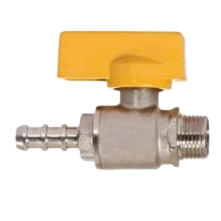BIS certification for valve fittings for use with liquefied petroleum gas cylinders of more than 5 litre water capacity Part 2 Valve fittings for newly manufactured LPG cylinders-IS 8737

Product Description
Valve fittings for liquefied petroleum gas (LPG) cylinders
serve as essential safety components, providing secure gas containment and
controlled gas release. For cylinders exceeding 5 liters in water capacity, IS
8737 Part 2 specifies the standards for valve fittings on newly manufactured
LPG cylinders. BIS certification for these valve fittings confirms their
adherence to stringent safety and performance standards, ensuring secure use in
both residential and industrial applications.
Introduction
The Bureau of Indian Standards (BIS) mandates that valve
fittings for large LPG cylinders comply with IS 8737 Part 2. This standard sets
forth specific requirements for safety, leak prevention, and pressure handling,
minimizing the risks associated with LPG usage. BIS certification under this
standard allows manufacturers to display the ISI mark on valve fittings,
assuring consumers of compliance with national safety standards.
Why is BIS Certification Necessary for Valve Fittings on
LPG Cylinders?
Since LPG is a highly flammable gas, valve fittings must
meet rigorous safety standards to prevent leaks and ensure proper gas
regulation. BIS certification under IS 8737 Part 2 verifies that the fittings
meet essential safety requirements, reducing the risk of accidents, fires, or
gas leakage, and ensuring user safety.
Overview of Indian Standard IS 8737 Part 2
IS 8737 Part 2 outlines crucial safety and performance standards for LPG
cylinder valve fittings. These include leak resistance to prevent gas leaks,
pressure tolerance to withstand high LPG storage pressures, and corrosion
resistance for durability. The standard ensures secure gas regulation for safe
release and specifies impact resistance to protect fittings from mechanical
damage. These requirements collectively enhance the reliability, safety, and
longevity of valve fittings used in LPG cylinders.
Process for BIS Certification
The BIS certification process for LPG valve fittings under
IS 8737 Part 2 includes:
- Application Submission: Manufacturers submit an application
with relevant product details and technical specifications.
- Document Review: BIS reviews the documents to verify
conformity with IS 8737 Part 2.
- Factory Inspection: BIS conducts an inspection to ensure
manufacturing quality and process compliance with safety standards.
- Sample Testing: Valve samples undergo testing at
BIS-accredited labs to confirm compliance with safety and performance criteria.
- Certification Approval: After successful inspection and
testing, BIS grants certification, allowing the ISI mark on the valve fittings.
Documents Required for BIS Certification
To apply for BIS certification for valve fittings under IS
8737 Part 2, manufacturers must provide:
- Application form
- Product specifications and technical drawings
- Quality control documentation
- Test reports from BIS-accredited labs
- Factory details and production process information
- Proof of business registration
- Declaration of conformity with IS 8737 Part 2 standards
BIS ISI Mark Certification Costing And Timeline
To Know The Process in Detail, Please Visit:
- BIS ISI Mark Certification for Domestic Manufactures
- BIS ISI Mark Certification for Foreign Manufactures
Under BIS Registration Products ISI and CRS
Conclusion
BIS certification for valve fittings under IS 8737 Part 2
is crucial for ensuring the safety and reliability of LPG cylinders. Compliance
with these standards reduces risks and enhances user safety, making certified
fittings a trusted choice for both consumers and industrial users. EVTL India
offers expert consultancy for manufacturers seeking BIS certification, guiding
them through the process to achieve compliance and market readiness for their
LPG valve fittings.























